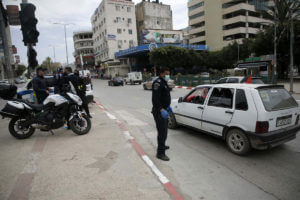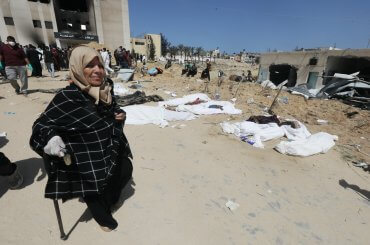At 6:00 p.m. Safwan Fayyad took a break half-way through his 24-hour shift. By sunrise tomorrow he will enter the foyer of his home, a two-hour drive from the Ramallah Medical Complex, a hulking gated hospital compound in the West Bank’s de facto capital and the main triage zone for COVID-19 patients in the region. Once inside the doorway, he implements a rigorous disinfecting regime. The 30-year-old senior resident and internist will slip off his shoes and sterilize them with bleach, and remove all of his clothing and drop the soft fabrics directly into the washing machine. Then, take a hot shower.
Palestinians are now one month into a state of emergency where early lockdown policies slowed the spread of the novel coronavirus, with Fayyad on the front lines.
When he’s not working Fayyad is isolating with his wife and two relatives. “We don’t touch, I don’t even shake the hands of my family”—“no kissing, no hugs, except for my wife.”
“We know about H1N1, but it never has been like this current epidemic,” he said.
“It’s a micro enemy because you’ll never be able to see it. You never know if the patient in front of you is carrying the disease or not,” he said “There is no typical presentation of this disease. Every patient comes with different presentation and the lab tests, they can be misleading.”
“We have seen three or four cases where they tested the patient multiple times, and only on the third and fourth-time test the results were positive,” Fayyad said.
Many of his patients are relatively young, in their 40s and 50s. Fayyad says that it is a reflection of age distribution in the Palestinian population rather than who is most likely to contract COVID-19 or become seriously ill from the disease.
“We deal with around 400 patients per shift in the ER,” Fayyad told me via telephone between rounds. He runs CT scans, chest x-rays and swabs patients for the coronavirus test kits. He sees the more severe cases that make it to the internal medicine ward. Anywhere from 20 to 40 patients a day will pass through his floor. Those who test positive for COVID-19 are transferred to the Hugo Chavez Ophthalmic Hospital, now converted into an intensive care facility. It is just outside of Ramallah in the bucolic town of Turmus Ayya, previously known for lavish summer homes and an equestrian club.
While ventilators run scarce in the West Bank, only 256 for a population of 3.2 million, Fayyad rarely intubates, but that doesn’t mean more ventilators are not needed. He tells me the Ramallah hospital has been converted into a massive diagnostic center, with triage tents outdoors. His patients have needed oxygen mechanically flushed into their lungs. They suffer from acute respiratory distress syndrome or ARDS. Generally, this disorder impedes the lungs’ ability to self-inflate.
Research out of Wuhan, China, where this strain of the coronavirus is thought to have originated, shows the survival rate for COVID-19 patients with ARDS is slightly less than 50 percent, which is about 10 percent lower than the survival rate for ARDS from other causes.
“Many patients developed microthrombosis in their lung tissue, it blocks the small vessels in the lungs. That means the oxygen that gets inside of the lung can’t be exchanged with the blood. That’s the main function of the lungs,” Fayyad said. “Microthrombosis is not common with the flu.”
“With the common flu or the swine flu, it’s a compliance issue with the lung. It means the lungs cannot expand, even with a mechanical ventilator.” Yet, “in these COVID-19 patients, the lungs can expand easily, but there is an exchange issue.”
“Standard treatment” he orders is a dose of anticoagulants to thin the blood and antibiotics. “When a patient has a viral illness, especially when a patient has viral pneumonia, bacteria can easily break into lung tissue.”
“We call this a superadded bacterial infection, or secondary infection.” With his current patients, “there is damage to each and every organ in the body, to the heart to the muscles, to the primary organs, the lungs.”

The first confirmed case of the coronavirus in the West Bank was found on March 5 in Bethlehem. A group of Greek tourists spread the virus to locals they interacted with on their trip. An aggressive lockdown across Bethlehem seems to have stopped the spread. Since April 10 there have been no new cases in the city, but elsewhere in the West Bank the virus has transmitted through the community.
In the last two weeks most of the new cases could be traced back to Palestinian day laborers working in Israel who returned home to the West Bank, amounting to the origin of three-quarters of all of the COVID-19 cases in the West Bank. While Israel and the occupied Palestinian territory have roughly equal population sizes, the virus has proliferated in Israel. Last February 344,000 tourists visited Israel, compared to estimates of around 250,000 in the West Bank, most of whom stopped in Bethlehem. As of Thursday, Israel has 12,591 confirmed cases of COVID-19 while only 295 cases have surfaced the West Bank and Gaza, of whom two died. Both had multiple chronic diseases.
The Palestinian Ministry of Foreign Affairs and Expatriates was quick to note there are more confirmed cases of COVID-19 among Palestinians in the diaspora, exceeding 500 “including 349 cases in the United States alone” as of April 8. “There are 23 deaths; 15 of them in the United States,” said an announcement to reporters.
Fayyad says the low contraction rates are masking the vulnerabilities in Palestinian healthcare. Already there are protective gear shortages. He is rationed one N95 respirator a week, “I clean it with alcohol.”
“Until now we are keeping pace with the patient load,” yet, “The issues over here is we have a low patient to bed ratio. If we face a serious outbreak where a majority of people would get sick that would be a disaster here,” he warned.
“In Ramallah we have just one government hospital here. As we can see, even in the U.S., the private hospitals can’t really deal with the disaster as well as government hospitals,” he said. Staffing shortages are also beginning to emerge as a number of healthcare workers were sent into isolation after exposure from patients and their companions.
“The situation over here is complicated, everything comes in contact with politics. However you think about the situation,” Fayyad said, explaining he wants the Palestinian government to build more hospitals and increase international international cooperation.
“The situation over here is from a crisis to crisis,” he said. “We need help, we can’t do it alone.”
The United Nations warned this week the Palestinian Authority is facing financial collapses amid the pandemic. Ramallah enacted a “six-month austerity plan,” expecting a 70 percent loss in revenue in the coming months and estimating it will incur $1.4 billion in debt. To cover some of those losses, today Palestinian leaders announced they would take out a loan from Israel for an unspecified amount.
Earlier in the week the Palestinian Minister of National Economy Khaled Osaily cautioned, “we have enough supply stock to meet the needs of our citizens for 3 to 6 months.” The Palestine Monetary Authority reported that 30 percent of checks have bounced during the current state of emergency.
“The coronavirus gave us the chance to focus on the things that matter to us. Everyone can now clearly see how living in a wealthy country, once so glittery to imagine, is meaningless if there is no strong underline healthcare system to sufficiently treat the population,” Fayyad reflected.”
“While the world is large, this pandemic has shown how small it can feel,” he said.



Go to Twitter & type in: #TheGazaYouDontSee